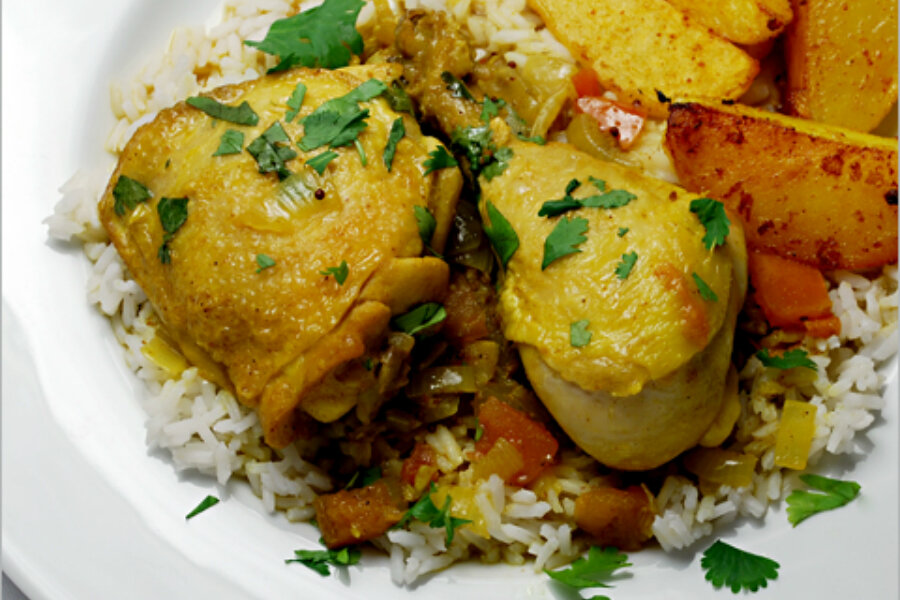Chicken curry with rice
Loading...
One of the perils of living in a city like Chicago, with its rich cultural diversity and well-deserved reputation for authentic food of all ethnic stripes, is that your taste buds get spoiled.
When recent chilly, drizzly weather put me in the mood for attempting a curry dish, my spoiled taste buds were envisioning the robust flavors and aromas of Devon Avenue. The practical side of me, however, was looking for something simple, something doable on a weeknight.
I looked around at numerous recipes. Some sounded deliciously authentic, but more complicated than I felt like tackling at the moment. Others sounded a little too basic, a little to aimed at the American palate. Finally, I settled on one that had "good bone structure" – a satisfying number and variety of fresh ingredients and spices – then tweaked it a bit, adding a little heat and the liveliness of fresh cilantro.
In a New York Times article, "Vegetables Dressed In Chinese Robes," Mark Bittman said of a shortcut using oyster sauce, "Admittedly this isn't the most nuanced way to make Chinese-like food at home...." The term Chinese-like jumped out at me. So many ethnic dishes we cook at home are exactly that. Inspired by the original cuisine, like the original cuisine, but not exactly it. And often that's OK. That was the case with this Indian-like chicken curry. It was not the authentically Indian flavor my taste buds were expecting, but it was fragrant, complex and satisfying on a chilly night.
Chicken Curry
Serves 4
Canola oil
8 pieces chicken (I used thighs and drumsticks – see Kitchen Notes)
Salt and freshly ground pepper, to taste
2 medium yellow onions, chopped
4 cloves garlic, minced
2-inch piece of ginger, minced
1 teaspoon brown mustard seeds (or yellow – see Kitchen Notes)
1 teaspoon cumin seeds
1 teaspoon turmeric
2 tablespoons curry powder (see Kitchen Notes)
1/4 to 1/2 teaspoon cayenne pepper (optional – see Kitchen Notes)
2 medium tomatoes, chopped
3-inch stick cinnamon
2 cups reduced-sodium chicken stock
1 teaspoon garam masala
1/2 cup fresh cilantro leaves, roughly chopped
Cooked white rice
1. Heat a large, lidded nonstick skillet over medium-high flame. Add 2 tablespoons canola oil. Season chicken with salt and pepper and brown on both sides, 4 to 5 minutes per side. Reduce heat to medium and transfer chicken to plate. Add chopped onion to pan and sauté, stirring occasionally, until tender, 4 to 5 minutes.
2. Add garlic and ginger, adding more oil to pan if needed (I ended up adding a little oil a couple of times during the cooking process), and cook until fragrant, about 1 minute. Add cumin and mustard seed, cooking until the mustard seeds begin to "pop." Add the turmeric, curry powder and cayenne powder (if using) and cook, stirring constantly, 1 to 2 minutes.
3. Add the chopped tomatoes and cook 3 to 4 minutes, stirring occasionally. Add the chicken broth and cinnamon stick, stirring to combine ingredients and scraping up any browned bits. Return chicken and any accumulated juices to the pan. Cover and simmer until chicken is cooked, 35 to 45 minutes.
4. Transfer chicken to a plate. Stir in garam masala and most of the cilantro into the pan, reserving some to use as a garnish. Cook uncovered for just a minute or two to incorporate flavors. Garam masala loses its flavor as it cooks, so don't overcook. Tastes sauce and add salt, if needed.
5. To serve, spoon rice onto 4 plates. Spoon sauce over rice and top with 2 chicken pieces. Garnish with chopped cilantro.
Kitchen Notes
Drumsticks, thighs or whole chicken? I used drumsticks and thighs, but you can use a whole chicken (about 3 pounds or so) cut into 8 pieces.
Mustard seeds – brown? Yellow? Mustard seeds appear a lot in Indian cuisine. Generally, brown seeds are preferred for their pungent flavor and a little kick of heat. If you can’t find brown, yellow will do.
Curry powder and cayenne pepper. Unlike, say, cumin or turmeric, curry isn't a single ingredient. It's a mix of spices that varies widely – by country, by region and by what’s being cooked. In India, it even varies kitchen to kitchen, because cooks make it up fresh every day. You'll find lots of recipes online for making your own if you have the time and inclination. If you're buying prepared curry powder, try to seek out ethnic markets or actual spice shops such as The Spice House or Penzeys Spices. Because curries vary so greatly, so will the heat intensity, from none at all to quite hot. Choose one that you can use the full 2 tablespoons the recipe calls for to get the maximum flavor. The curry powder I had on hand was a mild one, so I added 1/2 teaspoon of cayenne pepper to heat things up a bit.
Related post on Blue Kitchen: Vegetarian Indian dish packs heat, authentic flavor: Tofu Curry








